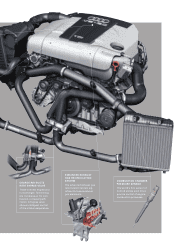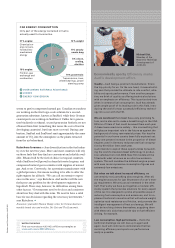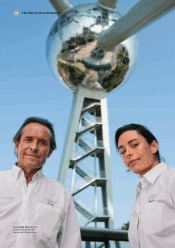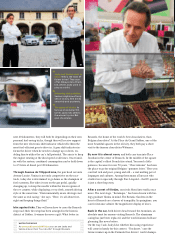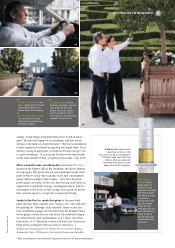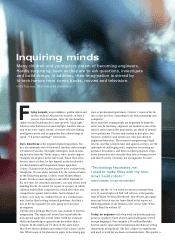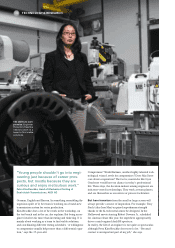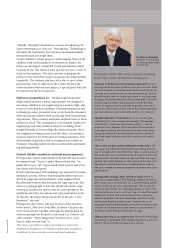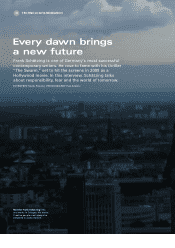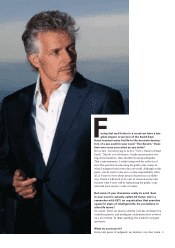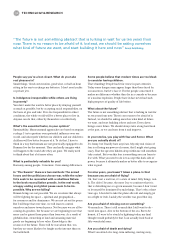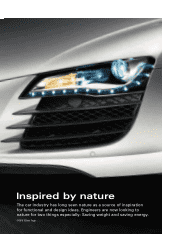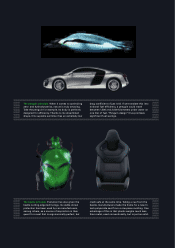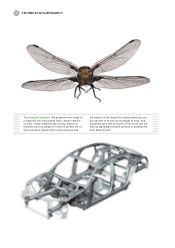Audi 2007 Annual Report Download - page 73
Download and view the complete annual report
Please find page 73 of the 2007 Audi annual report below. You can navigate through the pages in the report by either clicking on the pages listed below, or by using the keyword search tool below to find specific information within the annual report.
Premium-class HR work means making
Audi the most attractive employer.
Dr. Werner Widuckel,
Member of the Board
for Human Resources
of AUDI AG
Audi can only live up to its premium reputation by em-
ploying extremely well-qualified men and women. With-
out a motivated, committed and healthy workforce, our
success as a company would be unimaginable. That is
why HR holds such an important place in our business
strategy: We invest heavily in hiring new staff, and also
in ensuring first-rate, integrated personnel develop-
ment. To support Audi’s worldwide growth, we will in
future be offering more and more job rotation between
our national and international locations, for instance.
Equally important, if not more so, is our employees’
contribution to the company’s success. The success
of AUDI AG is what our employees make it – that is
what we firmly believe. Premium-class HR work there-
fore means making the Company the most attractive
employer. After all, our employees aspire to perform,
and they need the best possible conditions in which
to do so.
This is why we give special attention to learning – life-
long learning. We are committed to providing employ-
ees of all ages with the skills they need, in every area of
the business, from manufacturing through to technical
development. We also take into account that the way a
person learns will change in the course of his life. Com-
panies who let the know-how of experienced employ-
ees go to waste are merely jeopardizing their own com-
petitiveness.
Demographic change, then, which so many seem to
view as a catastrophe in the making, instead should be
seen much more as the basis for a pact between gener-
ations, opening up new opportunities. This is why, for
example, Audi relies on mixed-age teams, so that tried
and tested know-how is not lost. The old idea that work
makes you ill and that you should strive to retire as
early as possible has never been less true than today
and should finally be laid to rest. Instead, let us all
recognize that trusting people to perform a wide range
of tasks is the best way to get them to contribute to a
company’s well-being, whatever their age.
Lifelong learning is an opportunity: This way of thinking
represents a paradigm shift. Mastering this is a job not
just for HR but for the Company as a whole.
“Initially, I thought I’d embark on a career in technology be-
cause everything is so clear-cut,” she explains. “Technology is
obviously the foundation, but it involves much more human
interaction than you might think.”
Cederic Schäfer’s school project is rather similar. None of the
children work on their projects by themselves. Rather, the
robots are developed, assembled, tested and then fine-tuned
by teams of ten. The children meet up once or twice a week to
work on their projects. The aim is not just to program the
robots so they reach their targets as quickly and independently
as possible. The students also have to be able to give a short
presentation. Also, in addition to the contest between the
robots they have built on their project, a special prize will also
be awarded for the best teamwork.
National competitions like “Schüler experimentieren”
(High-school students conduct experiments) are designed to
encourage children to see engineering in a positive light, and
to get a real feeling for technology. Conventional physics and
technology lessons, presented in an overly theoretical manner,
often discourage students from conducting their own practical
experiments. Their curiosity and innate inquisitiveness is often
stifled as a result. The consequence is that student numbers in
engineering and other technical subjects are falling. Even
though Germany is a technologically advanced nation, there
are companies lacking in new scientific talent. According to
statistics issued by the Federation of German Industries, tens
of thousands of specialist staff are required, particularly in
Germany’s flagship industries such as automobile manufactur-
ing and engineering.
Cederic Schäfer needed no external encouragement.
He began his creative experiments all by himself, just because
he enjoyed them. “I used to make films with my toys,” ex-
plains the 12-year-old. “I got a small video camera and acted
out scenes with the figures.”
He first experimented with modeling clay and used it to make
animated cartoons. Now he builds small machines and cars,
which he programs and mechanizes. Audi engineer Petra
Kim-Reschke believes this is exactly the right way to go. Her
advice to young people is that they should not choose engi-
neering as a profession just because of career prospects, but
mostly because they are curious and enjoy meticulous work.
To this day, she enjoys the practical side of her job: “I love
hardware!” she says.
Perhaps one day Cederic will also become a hero inventor,
better than Q, MacGyver, Iron Man, Professor Calculus and
Gyro Gearloose put together. Although the famous duck in-
ventor is perhaps not the perfect role model, as Cederic criti-
cally remarks: “Those things that Gearloose does – now
they’re really over the top!” •
Titus Arnu, a specialist in culture and media, is a reporter for
Süddeutsche Zeitung, one of Germany’s leading daily newspapers.
In addition, he also writes for science and travel magazines.
////////////////////////////////////////////////////////////////////////////////////////////////////////////////////////
////////////////////////////////////////////////////////////////////////////////////////////////////////////////////////
////////////////////////////////////////////////////////////////////////////////////////////////////////////////////////
////////////////////////////////////////////////////////////////////////////////////////////////////////////////////////
////////////////////////////////////////////////////////////////////////////////////////////////////////////////////////
////////////////////////////////////////////////////////////////////////////////////////////////////////////////////////
Photo: AUDI AG


